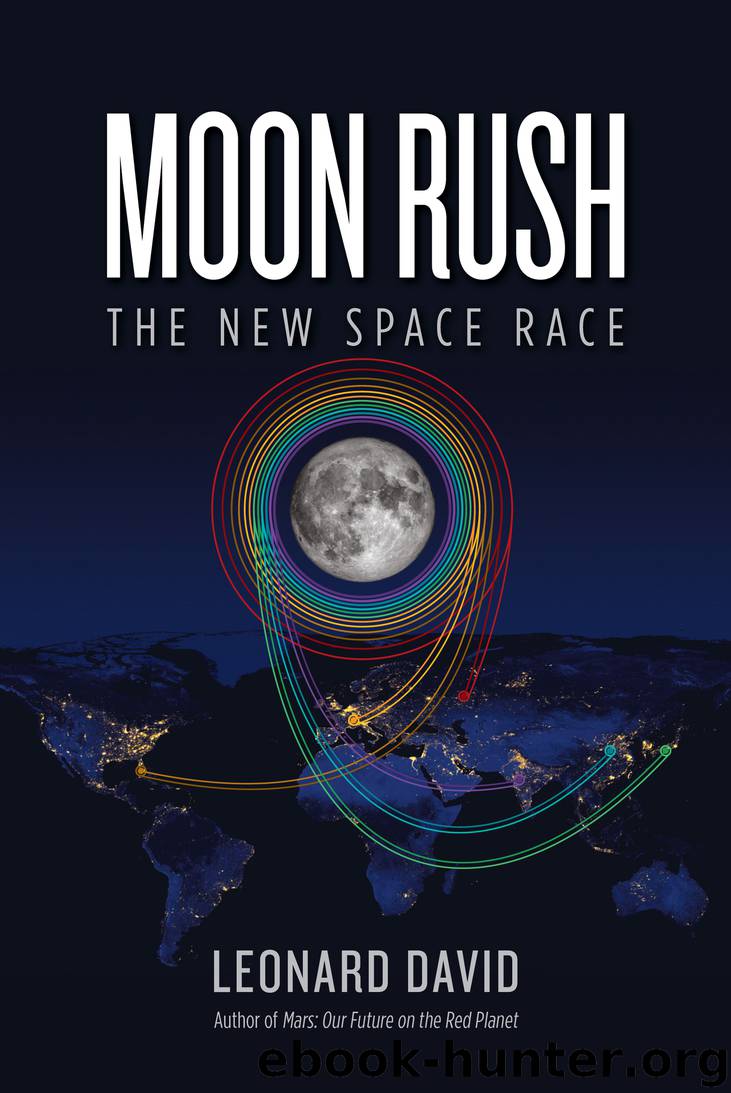Moon Rush: The New Space Race by Leonard David

Author:Leonard David
Language: eng
Format: epub
Publisher: National Geographic
Published: 2019-05-06T23:00:00+00:00
* * *
WITHOUT QUESTION, NASA’s long-lived Lunar Reconnaissance Orbiter (LRO) has been a game changer in the ability to inspect the Moon. On the job since entering orbit around the Moon on June 23, 2009, LRO is still making fundamental scientific discoveries. The next humans to visit the Moon will know precisely where to land courtesy of LRO imagery.
There’s likely no person on Earth who has accumulated more day-to-day face time with the Moon than Mark Robinson, principal investigator at Arizona State University of the LRO Camera (LROC). Over the years, LROC systems have yielded vivid imagery from the Moon—imagery that has only intensified Robinson’s reactions. “If anything, it’s more beautiful and more mysterious…and even more inviting than it has ever been,” he says. It may look cold, beat-up, lifeless, and foreboding to some, but the LROC images prove otherwise.
Two narrow-angle cameras on the LROC produce high-resolution, black-and-white images of the surface, capturing photos of the poles with resolutions down to about 3.3 feet. A third wide-angle camera takes color and ultraviolet images over the complete lunar surface at an almost 330-foot resolution. Images from all the cameras identify potential resources for human crews and safe landing sites for both robotic and crew-carrying spacecraft.
LROC has been used for mapping both the permanent shadow and the sunlit regions on the Moon. It has also helped estimate the impact rates of objects smacking into the lunar surface over the past decade. The Moon’s exterior is predominantly shaped by impacts of cometary and asteroidal materials—a process that is continuous. Since LRO has operated in Moon orbit for so long, the craft loops back over the same region time and time again, snapping images of the same area. These surface pictures show the rate of new lunar crater production and provide a striking picture, so to speak, showing how pelting micrometeorites create craters and modify the lunar surface.
By combining LROC imagery and historical data, cartographers have been able to create detailed maps of the Apollo landing sites. High-resolution imagery of the six landing spots, from Apollo 11’s 1969 landing to Apollo 17 in 1972, reveals the lunar module descent stages sitting on the Moon’s surface, left behind by the departing astronauts, as well as lunar surface experiment packages and parked rovers. Faint trails of the astronauts’ footprints show up, including observable tracks from the last three Apollo landing excursions as those crews rolled across the Moon’s surface in their rovers.
The LROC images even show American flags still standing and casting shadows at all the sites, except for Tranquility Base, the Apollo 11 landing site. The rocket blast as Armstrong and Aldrin departed the scene may have knocked over that flag. Some speculate the flags have been bleached white by the Sun’s harsh ultraviolet radiation, but no one really knows the color or condition of the flags at this point. Future expeditions to those sites will find out.
Download
This site does not store any files on its server. We only index and link to content provided by other sites. Please contact the content providers to delete copyright contents if any and email us, we'll remove relevant links or contents immediately.
| Aerodynamics | Aircraft Design & Construction |
| Astronautics & Space Flight | Avionics |
| Gas Dynamics | Propulsion Technology |
Whiskies Galore by Ian Buxton(41937)
Introduction to Aircraft Design (Cambridge Aerospace Series) by John P. Fielding(33092)
Small Unmanned Fixed-wing Aircraft Design by Andrew J. Keane Andras Sobester James P. Scanlan & András Sóbester & James P. Scanlan(32764)
Craft Beer for the Homebrewer by Michael Agnew(18196)
Turbulence by E. J. Noyes(7977)
The Complete Stick Figure Physics Tutorials by Allen Sarah(7338)
Kaplan MCAT General Chemistry Review by Kaplan(6900)
The Thirst by Nesbo Jo(6877)
Bad Blood by John Carreyrou(6581)
Modelling of Convective Heat and Mass Transfer in Rotating Flows by Igor V. Shevchuk(6406)
Learning SQL by Alan Beaulieu(6237)
Weapons of Math Destruction by Cathy O'Neil(6214)
Man-made Catastrophes and Risk Information Concealment by Dmitry Chernov & Didier Sornette(5956)
Digital Minimalism by Cal Newport;(5704)
Life 3.0: Being Human in the Age of Artificial Intelligence by Tegmark Max(5514)
iGen by Jean M. Twenge(5385)
Secrets of Antigravity Propulsion: Tesla, UFOs, and Classified Aerospace Technology by Ph.D. Paul A. Laviolette(5333)
Design of Trajectory Optimization Approach for Space Maneuver Vehicle Skip Entry Problems by Runqi Chai & Al Savvaris & Antonios Tsourdos & Senchun Chai(5037)
Pale Blue Dot by Carl Sagan(4953)
